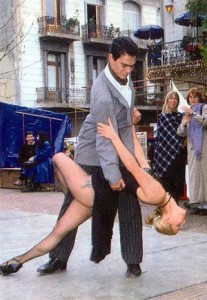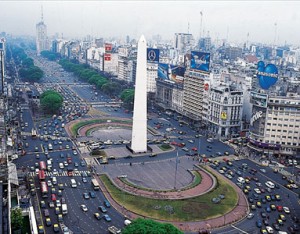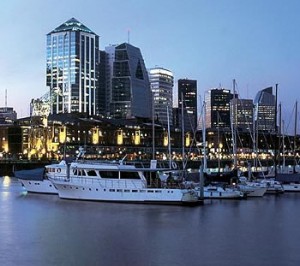Buenos Aires
The city of Tango endless, Buenos Aires is a city without complexes. The so-called Paris of South America, for its European style, Buenos Aires
has an atmosphere that attracts locals and visitors. In Buenos Aires the safety of narcissism, sometimes exaggerated, makes the capital of Argentina an attractive incentive in which mixed architecture of large buildings into luxury of the affluent neighborhoods with low houses workers of color. A megalopolis of 15 million people seems endless when you start off with the plane at the airport Ezeiza and is the natural gateway to tour South America.
With flights getting cheaper is a good choice for backpacking and you get to a country with one currency, the Argentine peso (ARS), very weak against the euro and the dollar. From the international airport, 35 km from downtown, you can catch buses that take 40 minutes and cost between 32 and 35 ARS (about 6 euros) or take the cheapest option is a public bus, number 86, which costs 1 , 35 ARS (0.20 euros) but it takes two hours.
Buenos Aires information:
Once in the center and even a large city, it is easier and cheaper to move because it has a highly developed transport system. With six subway lines, which is known in Argentina as the underground (0.70 ARS travel costs) and more than 150 bus lines or bus (the trip costs 0.80 ARS) can reach every corner of the city . To save costs one can choose an Internet that is affordable to avoid the high season in Argentina runs from November to February, coinciding with the summer in the southern hemisphere.
This city offers the possibility of a thematic circuit organized free (from August to December) can be known historic neighborhoods or major art exhibitions. In addition, you can make free downloads on the mobile or mp3 (www.bue.gov.ar / audio guides) with explanations of some of the most outstanding areas that are easy to follow since the city is divided into squares (130 m) why it is difficult to lose.
Eating is cheap even in the most luxurious restaurants as the main course can cost between 30 and 40 ARS (between 5 and 7 euros), a third of what it costs in Europe or the United States.Keep in mind that some charges on covered and not all restaurants accept credit cards for payment. But surely Buenos Aires offers good food rich in agricultural products and excellent meat, but preferably away from the city center.
The first important fact is that most of what can be seen on the streets after bonarenses is S. Century and is inspired by European buildings. The center is the first must-see is walkable, runs from Retiro to Sant Elm and Congress and around Puerto Madero, there are also the most tourist offices where get free maps. It is imperative to approach the 9 de Julio Avenue and the pedestrian streets Florida and Lavalle, which are essentially commercial and feature street vendors and musicians that bring color to the visit.
Following the walk is Plaza de Mayo, which is known for its history and its memorial to independence from Spain in 1810.Behind the Casa Rosada (or the presidential palace), the classic Metropolitan Cathedral and the Museum of the City Council recalled the importance of a country with a very recent history.
Visit Buenos Aires:
You can not leave the area without resorting Puerto Madero, the district less conventional than the old port warehouses have become cozy loft for offices and homes. In addition, you can visit a ship, lit up at night, exhibitions of painting and sculpture in which free access. This pleasant walk in Puerto Madero you can not leave without admiring the famous Bridge of the woman the Spanish architect Santiago Calatrava designed the shape of a couple dancing tango. It is precisely in the neighborhood that is south of downtown, San Telmo, where tango can be heard in his famous Sunday market where you can buy antiques in its narrow and picturesque streets while dancing. But you can dance the tango for free at many of the tasks in which part of the service to get you dancing after their famous Argentine beef taste. And along with the purely Argentine is also free pictures with Mafalda has been placed on a bench in the neighborhood, near the house where Quino first drew.
South of San Telmo is the most chaotic and emblematic of the capital, La Boca. Known for hosting the famous football stadium of Boca Juniors, an emblem for all Argentines. Even if something surprising in this neighborhood are colored houses of the working area, which have their origin in the Spanish and Italian immigrants who painted house with paint left over from the boats.
North of the city, the center is closer to retirement is one of the most luxurious in Buenos Aires but it contains much of the museums and the train station and largest city. To travel anywhere in the country agrees to ask the information office as the buses are cheap and are fully equipped for long distances.Another landmark is Recoleta district where you can visit the National Museum of Fine Arts and the impressive Recoleta cemetery, where it says that Eva Peron is buried but do not quite believe Buenos Aires.
The city’s cultural offer is impressive and there are a large number of music and drama performances and free exhibitions in both the street and in cultural centers (www.ccborges.org.ar), which can make the visit to great megalopolis round trip without spending much money.






